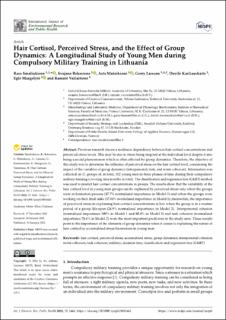| dc.contributor.author | Smaliukienė, Rasa | |
| dc.contributor.author | Bekesiene, Svajone | |
| dc.contributor.author | Mažeikienė, Asta | |
| dc.contributor.author | Larsson, Ulf Gerry | |
| dc.contributor.author | Karčiauskaitė, Dovilė | |
| dc.contributor.author | Mazgelytė, Eglė | |
| dc.contributor.author | Vaičaitienė, Ramutė | |
| dc.date.accessioned | 2023-02-15T09:03:29Z | |
| dc.date.available | 2023-02-15T09:03:29Z | |
| dc.date.created | 2022-05-13T15:49:57Z | |
| dc.date.issued | 2022 | |
| dc.identifier.citation | International Journal of Environmental Research and Public Health (IJERPH). 2022, 19 (3), . | en_US |
| dc.identifier.issn | 1661-7827 | |
| dc.identifier.uri | https://hdl.handle.net/11250/3050942 | |
| dc.description.abstract | Previous research shows a nonlinear dependency between hair cortisol concentrations and perceived stress levels. This may be due to stress being targeted at the individual level despite it also being a social phenomenon which is often affected by group dynamics. Therefore, the objective of this study was to determine the influence of perceived stress on the hair cortisol level, considering the impact of the variables of group dynamics (interpersonal, task, and norm cohesion). Information was collected on 11 groups of, in total, 112 young men in three phases of time during their compulsory military training (covering nine months in total). The classification and regression tree (C&RT) method was used to predict hair cortisol concentrations in groups. The results show that the variability of the hair cortisol level in young men groups can be explained by perceived stress only when the groups were in formation process (47.7% normalised importance in Model 1) and when the groups were working on their final tasks (37.80% normalised importance in Model 3); meanwhile, the importance of perceived stress in explaining hair cortisol concentrations is low when the group is in a routine period of a group life-span (28.9% normalised importance in Model 2). Interpersonal cohesion (normalised importance 100% in Model 1 and 80.0% in Model 3) and task cohesion (normalised importance 78.6% in Model 2) were the most important predictors in the study area. These results point to the importance of the elements of group dynamics when it comes to explaining the nature of hair cortisol as accumulated stress biomarkers in young men. | |
| dc.language.iso | eng | en_US |
| dc.rights | Navngivelse 4.0 Internasjonal | * |
| dc.rights.uri | http://creativecommons.org/licenses/by/4.0/deed.no | * |
| dc.title | Hair Cortisol, Perceived Stress, and the Effect of Group Dynamics: A Longitudinal Study of Young Men during Compulsory Military Training in Lithuania | en_US |
| dc.title.alternative | Hair Cortisol, Perceived Stress, and the Effect of Group Dynamics: A Longitudinal Study of Young Men during Compulsory Military Training in Lithuania | en_US |
| dc.type | Peer reviewed | en_US |
| dc.type | Journal article | en_US |
| dc.description.version | publishedVersion | |
| dc.source.pagenumber | 0 | en_US |
| dc.source.volume | 19 | en_US |
| dc.source.journal | International Journal of Environmental Research and Public Health (IJERPH) | en_US |
| dc.source.issue | 3 | en_US |
| dc.identifier.doi | 10.3390/ijerph19031663 | |
| dc.identifier.cristin | 2024494 | |
| cristin.ispublished | true | |
| cristin.fulltext | original | |
| cristin.qualitycode | 1 | |

